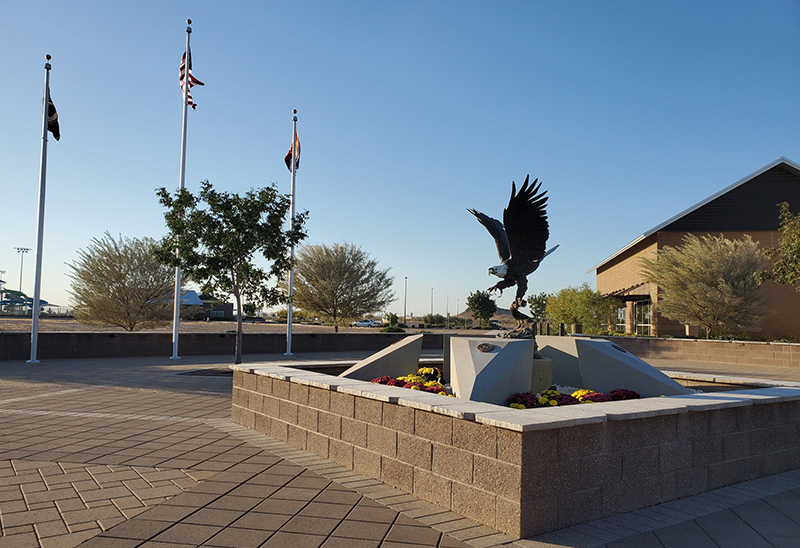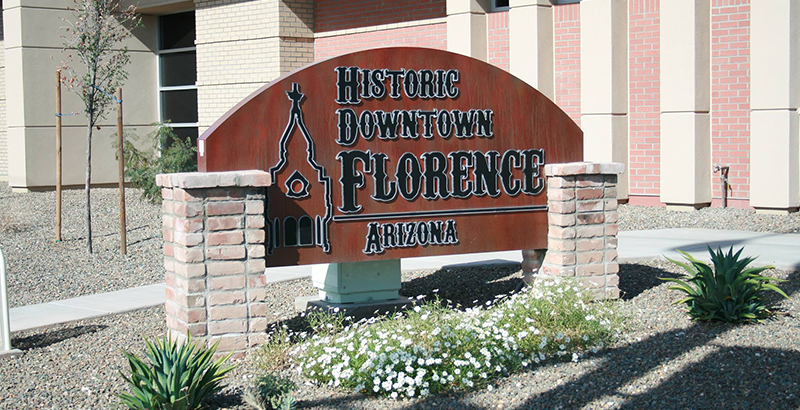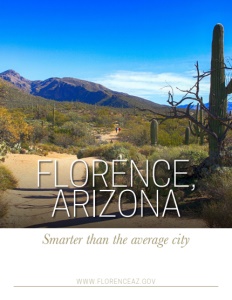Florence, Arizona
Smarter than the average city
Business View Magazine interviews Brent Billingsley, Town Manager of Florence, Arizona, for our focus on Economic Development in American Cities.
The Town of Florence was founded in 1866 and is the sixth-oldest, non-Native American settlement in Arizona. The county seat of Pinal County, Florence is an employment and government hub for the region, and actually grows in population during the day (something that is atypical among rural communities). Three major transportation corridors – Highway 287, Highway 79, and Hunt Highway – run through the town, providing direct connectivity to the suburban and metropolitan centers of Phoenix (to the north) and Tucson (to the south), also giving access to the interstate highway systems that carry goods to the surrounding region.
Despite a growing year-round population (about 28,000 residents in 2019), and thousands of additional visitors that spend their winters in town, Florence is still seen as a rural community – but one that is close to the amenities associated with urban lifestyles. Nonetheless, it is the access to trails, open space, wildlife, and beautiful off-road adventures that makes Florence a destination for many thrill-seekers, as well as those that are simply looking for a change of pace. Perhaps most of all, Florence is proud of its heritage and the designation of its beautiful downtown as a National Historic District, with dozens of homes and businesses listed on the National Register of Historic Places.
But beyond its exceptional outer charm and beauty, the Town of Florence is taking on the mantle of a “Smart City” in the most innovative and future-thinking ways. Business View Magazine recently spoke with Brent Billingsley, Florence’s Town Manager, for insights and details on the remarkable “smart” projects his community is implementing. The following is an edited transcript of that conversation.
BVM: How are you positioning Florence differently than other Smart Cities?
Billingsley: “A lot of cities around the world have incorporated Smart City technology in the way they do business. The challenge I have with what’s being done by others is it’s not being done in a comprehensive or as effective way as it can be. Any city can purchase smart technologies: Big Belly trash cans that have sensors that notify when the trash is full, thereby saving labor; an electronic system that allows automated reading of utility meters; a whole myriad of systems and sensors and software. But they are all proprietary and you can’t cross-populate the information.
 “We wanted to figure out a way to be smarter than everyone else. So, instead of having separate vendors for our trash cans, and our water meters, and our GPS vehicle tracking, and our smart lighting, etc., we wanted to set up a system where the Town owns the database and has the ability to collect all this real time information in a way that no one is doing at this time. We’re a small town, we don’t have a large budget, but we have creative, hardworking people, including our top-notch Director of IT, Trenton Shaffer. That is critical.”
“We wanted to figure out a way to be smarter than everyone else. So, instead of having separate vendors for our trash cans, and our water meters, and our GPS vehicle tracking, and our smart lighting, etc., we wanted to set up a system where the Town owns the database and has the ability to collect all this real time information in a way that no one is doing at this time. We’re a small town, we don’t have a large budget, but we have creative, hardworking people, including our top-notch Director of IT, Trenton Shaffer. That is critical.”
BVM: What steps were undertaken to move the project forward?
Billingsley: “As part of this process, we needed to bring on experts from different sectors to assist us in meeting our goal. The other thing we did quite well was to look at safety and security first. The first company we brought in was SUBEX – renowned, worldwide, in the cybersecurity arena. We brought them on as our first partner to make sure that people’s private information would be absolutely protected, in terms of what we did in placing remote sensing technology, collecting that data, and the use of that data in a relationship database.
“The next question was what type of platform could we utilize so we had that interface between remote sensing and the relational database? We decided on LoRaWAN, a Low Power, Wide Area (LPWA) networking protocol for wireless streaming of data in remote autonomous systems with long battery life. The second vendor that came on to help us set up the LoRaWAN network was IOT Advent Incorporated. We worked with them to figure out how to do something that had never been done before. Processing real-time data from thousands of endpoints into a big data-streaming system that processes the inputs produced by the network to obtain useful, valid, and hidden information. Furthermore, providing an interface that consolidates information from the different systems into a single pane of glass, ensuring everything blends together seamlessly.
“To move forward with this, we needed a funding source. So, capitalizing on our weakness (paying an employee to physically read every water meter and write down the numbers by hand each month) we were able to develop an RFP and build partnerships to do an advanced metering infrastructure (AMI) meter solution, where we could be a test site, a technology development platform, for our partner to do it here and market it elsewhere and work out the kinks. We are unique in that while that development’s going on, we continue to manually read meters until the technology is developed and everything works properly. We’re very proud of that – it was a really cool way to market ourselves to creative partners.”
BVM: What other strategic partnerships did you forge?
Billingsley: “Our next partnership was Ferguson Waterworks, a large construction firm based in Texas. And for meter technology, we chose Mueller, an industry leader and one of the largest producers of water hardware in the world. They were very interested to work with us and excited to implement one of the first AMI systems using LoRaWAN technology as the communication backbone. The testing is now complete, and we are in full systemwide install with respect to our AMI system. It gives us maximum flexibility and we own and control the data.
“Fairly recently, we partnered with Water Smart out of California for a software solution and phone apps, where the customer has real time data from their water meter. But it goes beyond that. Once it’s installed, we have leak detection set up for all our water mains, meters, etc. in our system, but it will also do leak detection of individual residences. You would get a notice through the app on your phone saying you have a water leak of so many gallons at your home. And you can go through a mobile checklist of all the things to check to find the leak. In another Smart City initiative, we partnered with T-Mobile for sophisticated tracking of our vehicles and reporting of data back to our fleet management staff.
 “In our initial planning phase, we realized there would be a lot of data streaming through our LoRaWAN network. We needed a solid backbone to back-haul the collected data to centralized cloud servers. We partnered with Zayo, a provider of mission-critical lit and dark fiber infrastructure, with dense, high-quality networks in every major market in North America and Western Europe. To add redundancy, we also partnered with Airebeam, a Colorado based wireless Internet service provider and fiber provider. Through these partnerships we are well on our way to establishing a regional fiber loop as the backbone of our Smart City infrastructure.”
“In our initial planning phase, we realized there would be a lot of data streaming through our LoRaWAN network. We needed a solid backbone to back-haul the collected data to centralized cloud servers. We partnered with Zayo, a provider of mission-critical lit and dark fiber infrastructure, with dense, high-quality networks in every major market in North America and Western Europe. To add redundancy, we also partnered with Airebeam, a Colorado based wireless Internet service provider and fiber provider. Through these partnerships we are well on our way to establishing a regional fiber loop as the backbone of our Smart City infrastructure.”
BVM: How does Smart City technology play a role in protecting your Historic District?
Billingsley: “Florence is one of the oldest towns in the Western United States, and we have one of the finest nationally registered Historic Districts in Arizona. Unfortunately, we’ve lost six of our treasured historic buildings in the last 20 years due to fires. A while ago, our Fire Marshal came to me and said, ‘We have to do something to stop losing these buildings.’ So, we worked with a vendor and came up with a solution that is a commercial wireless fire alarm. The great thing about that for a beautiful old building made of adobe is that there is no hole drilling, no running conduit or wires.
“The Town got very creative by telling anyone who owns a historic building in the downtown that we’ll pay for the backbone of the system if they pay for the individual units for their buildings. So, if you purchase or own one of those old buildings and need to bring it up to code, you can purchase a commercial fire alarm system at about 30 percent of the cost as a traditional system because we’re covering the monitoring and other expenses. And you don’t have to drill holes in your building. You sign an agreement with the Town to be part of the commercial wireless fire alarm program and then you work directly with the vendor to buy the sensors necessary for your building. The vendor installs them and then we cover the costs from there.
“Once all the Smart City sensors are in place and the whole system is brought online and functional, they will report into the database and then the key will be machine learning and artificial intelligence to utilize that data to make smart decisions. So, imagine a day in Florence, Arizona in the future when we know there’s a fire before there’s a call to the Fire Department. When the system speaks to itself, because it is all integrated, dispatches the firefighters, and then simultaneously turns on the pumps at the wells on the other side of town in order to build up the water pressure and supply that will be necessary to respond to the fire. That’s the beauty of collecting the data, and storing the data, and analyzing the data in a non-proprietary format that allows you to truly become a Smart City.”
AT A GLANCE
Florence, Arizona
WHAT: County seat of Pinal County; population approx. 28,000
WHERE: Central Arizona, 45 minutes from Tucson and Phoenix
WEBSITE: www.florenceaz.gov





